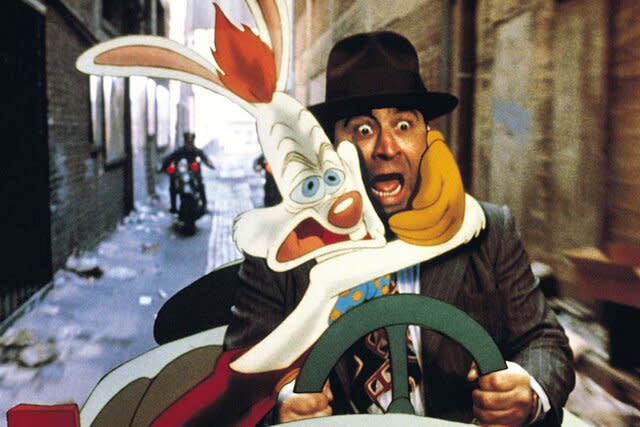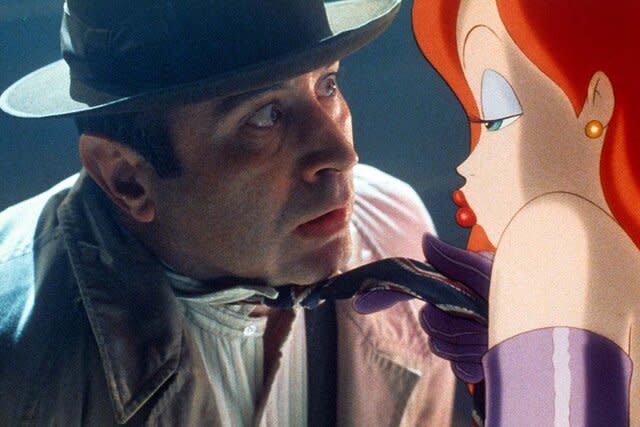Who Framed Roger Rabbit Turns 35: Voice of Roger Reflects on Filming Classic Cartoon Crossover
- Oops!Something went wrong.Please try again later.
- Oops!Something went wrong.Please try again later.
- Oops!Something went wrong.Please try again later.
Prior to 1988, the idea of mixing live-action with animation in the same space wasn't a novel idea. With that said, the execution left something to be desired; it was rudimentary at best and, ultimately, less immersive. Audiences had to suspend their disbelief far beyond the normal limit to buy that Gene Kelly was dancing with Jerry Mouse or Julie Andrews was being served by penguin waiters.
Mary Poppins, Anchors Aweigh, and Pete's Dragon might have done it first, but Who Framed Roger Rabbit perfected the art of mixing live-action with animation, taking it to places no one had ever imagined.
Who Framed Roger Rabbit breaks new ground
An adaptation of Gary K. Wolf's 1981 novel, Who Censored Roger Rabbit?, the film changed all the rules by giving cartoon characters tangible and physical impact on our own three-dimensional world — and vice versa. They cast shadows, left tangible marks on physical objects, and, most importantly, had the correct line of eyesight when looking at the human characters.
RELATED: Why Roger Rabbit, an animated (and legal) marvel, would be impossible today
Set in an alternate version of 1940s Los Angeles where cartoons (or "Toons") exist alongside regular people, Who Framed Roger Rabbit was a masterstroke from director Robert Zemeckis and executive producer Steven Spielberg, both hot off the recent success of Back to the Future.
Like R.K. Maroon, Spielberg convinced the biggest rival studios — Disney, Warner Bros., Columbia, MGM, Universal, and more — to loan out their most iconic characters for the project. Thanks to his unparalleled influence over the world of entertainment, audiences got to see Donald Duck, Daffy Duck, Mickey Mouse, Bugs Bunny, Betty Boop, Woody Woodpecker (a shining jewel in Universal's crown and a longtime mascot for the studio's theme parks) interact with one another for the first time in cinematic history.
But it's the original characters, like jaded private eye Eddie Valiant (the late Bob Hoskins), and the delightfully zany Roger (voiced by Charles Fleischer), who steal the show in this groundbreaking neo-noir that mixes the hard-boiled nature of Jake Gittes with the colorful animation of Fantasia. On paper, it seems like a combination that shouldn't work, but it totally does. There have been plenty of imitators (Ralph Bakshi’s Cool World, anyone?), but there is only one true Roger Rabbit.
In honor of the film's 35th anniversary, SYFY WIRE dug up our 2018 interview with Fleischer, where he discusses the origin of Roger's iconic voice and that long-awaited sequel. An established actor and comedian, Fleischer is also a published scholar, having written a paper on gamma rays for Cornell University in 2012. Who says you can't teach an old rabbit new tricks?
An interview with Charles Fleischer, the voice of Roger Rabbit
How did you end up getting the role of Roger Rabbit?
Bob Zemeckis had seen me do my stand-up. He asked me to come in and help them audition actors for the Eddie Valiant role, to read the character [of Roger] off-camera, so someone could react to it. After doing several of those, he offered me the job.
Did you know the movie was going to become the groundbreaking classic that it is considered today?
I was as close to knowing as possible. I was pretty certain it was a rather pedigreed project: Bob Zemeckis, Steven Spielberg, [animation director] Richard Williams. Everybody involved was amazingly talented, so I was pretty certain.
Where did the voice of Roger come from? Was it inspired by anything (or anyone) in particular?
Well, I think all characters emanate from the script and the actions and words of the character. In addition to that information, I had a visual of what Roger was gonna look like, so I had to adapt to that. Had he been extremely large, his voice would've had to be deeper, and if he was really little, it would be higher, so those are the parameters of emotional range of the character and the physical dimensions of the character's size.
Did the voice go through any evolutions before you started shooting?
It just got more Roger, and before it started shooting, they asked me to come up with some kind of a speech impediment. And that's where the "p-p-p-p-p" for the "please" came from.
Is there a reason they wanted that?
All cartoon characters, or most of them — according to Richard Williams — have some kind of speech impediment.
Going off that, what aspects of Roger's character do you most admire?
Oh, I would say the fact that he makes people laugh.
RELATED: Best Animated Films Streaming Now: The Super Mario Bros. Movie, Secret Life of Pets & More

Roger Rabbit and Bob Hoskins in Who Framed Roger Rabbit (1988) Photo: Buena Vista/courtesy Everett Collection
I read somewhere that you'd do your lines on set in a Roger Rabbit suit. Is this true?
Certainly, yes — it is true. I asked them to make me a costume to wear because that's what you do when you're an actor. You go to the set, you go to the trailer, you put on your costume. I didn't want to be seen wearing the same corduroy pants every day in England. We were filming at Elstree Studios in England around the same time that one of the Superman movies [The Quest for Peace] was being made, and apparently someone from [the] Superman crew saw me walking to the commissary or something and said something to the effect that "This Roger Rabbit movie's not gonna be good. I saw the guy playing Roger Rabbit, he doesn't even look like a rabbit."
Any other anecdotes from the set?
Oh, gee whiz. It was just an incredible experience, standing off-camera with my own mic, watching everything that Bob Hoskins did, so that I could essentially project myself into that space; so that if he grabbed me, I would have to react. I called it "Trans-Projectional Acting."
What was it like working with director Robert Zemeckis?
He did actually film me making the "p-p-p-p-p" noise, so that they would know how to animate it.
What was your favorite scene or line of dialogue?
Well, the whole thing was extraordinary. There was one scene where I'm sitting in an alley on a trash can and lamenting about the fact that Jessica had played Patty Cake [with Marvin Acme]. My youngest daughter is named Jessica, so the name Jessica had an emotional resonance within me that I think allowed me to reach a deeper place of love.

Bob Hoskins and Jessica Rabbit in Who Framed Roger Rabbit (1988) Photo: Buena Vista/Getty Images
In what ways did you interact with Bob Hoskins or Kathleen Turner to establish a repartee to best deliver your lines?
Kathleen Turner was not there for the principal photography. A woman named Betsy Brantley did that. [Turner] was added later. It was just like doing a regular movie, except I was off-camera.
How do you feel about the film sparking a renewed interest in animation and helping bring about the Disney Renaissance?
I'm proud to be associated with that movie in any capacity. I think it's a classic film and it still holds up.
If you were to be approached for a sequel all these years later, what would be your response?
When do we start?
In the mood for some Zemeckis-helmed adventures? Then pick up the Back to the Future trilogy from Universal Pictures Home Entertainment. For a trio of Spielberg classics, head over to Peacock Jurassic Park and The Lost World.
**EDITOR'S NOTE: A version of this article appeared on SYFY WIRE in June 2018 for the movie's 30th anniversary

